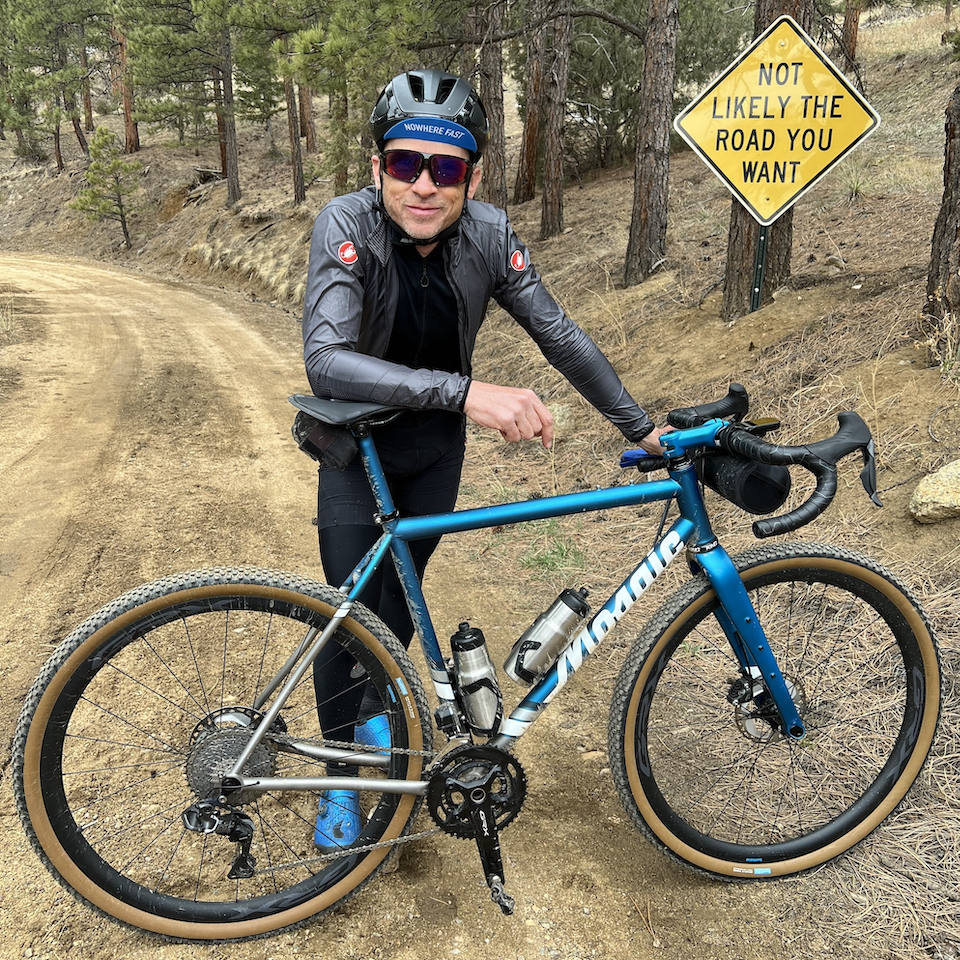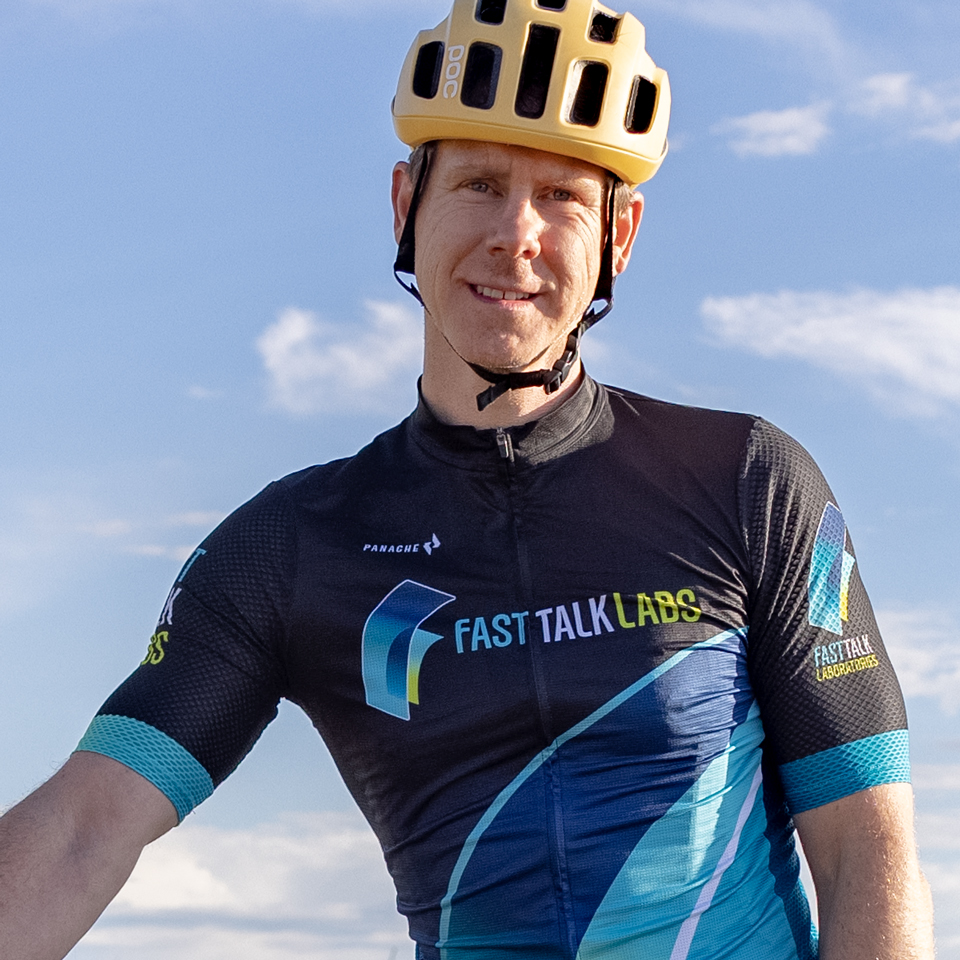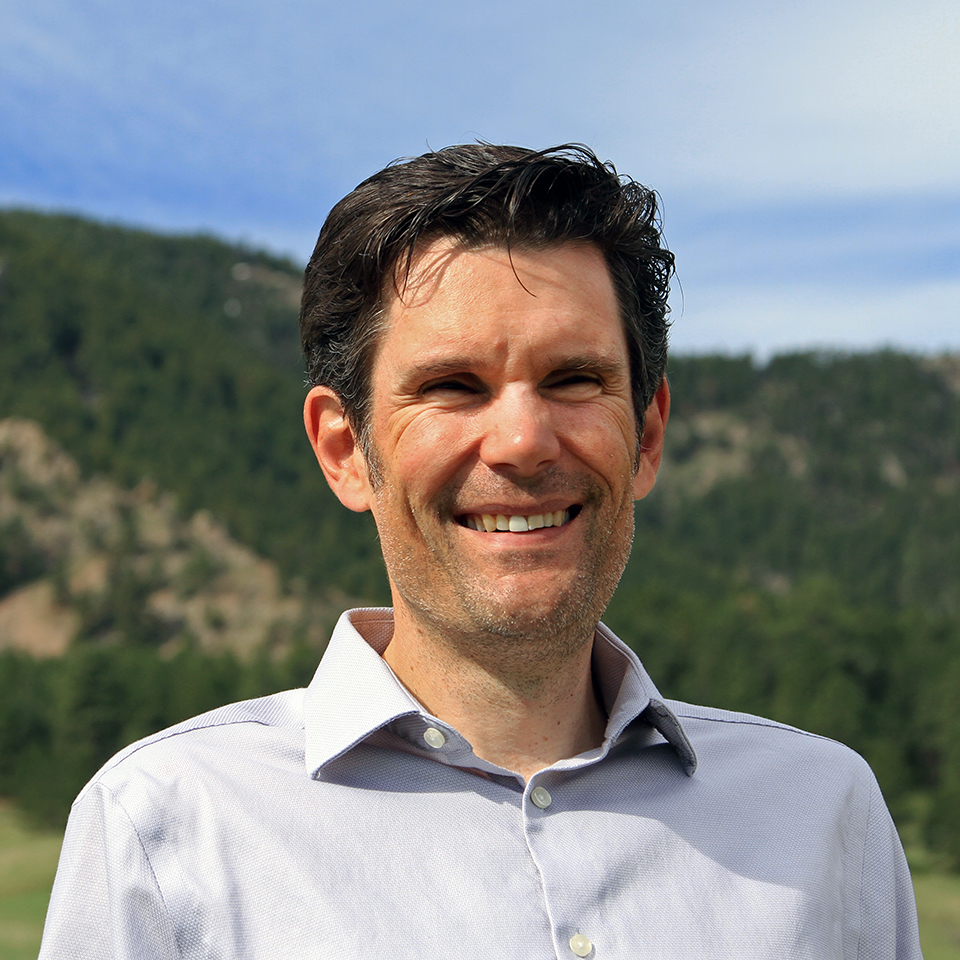
 Polarized Training Pathway
Polarized Training Pathway
Experts in this Pathway
What You’ll Learn
Go easy, go hard, get fast.
Polarized training, also known as 80/20 training, has been a topic of great interest and debate in endurance sports. It’s an approach that emerged from the real-world training data of elite endurance athletes and over the past two decades it has captured the attention of sports scientists and given us a trove of data and research to explore. Leading this charge is Dr. Stephen Seiler, an American sport scientist based at the University of Agder in Norway. In addition to being one of the preeminent experts on polarized training, Dr. Seiler is also an endurance athlete, so when he talks about applying this method, he draws from both personal experience and his work alongside the world’s best athletes.
Training is a constantly evolving topic as coaches, athletes, and sport scientists are always exploring new ideas on how to get to that next level of performance. At the very core of what you do as an athlete there are some basic fundamentals in play: 1) how often you train, 2) how much training you do, and 3) how the intensity of your training breaks out into easy, moderate, and hard.
Polarized training is based on research that shows endurance athletes improve their performance most when they do most of their training at low intensity. This strategy, coupled with a limited amount of very hard, high-intensity training, creates the optimal conditions for adaptation.
In this Pathway, we will introduce you to the mechanics of polarized training, explain what sets the polarized training method apart from other common approaches to training, and show you how you can apply the 80/20 training method to your own training program.
“No pain, no gain” is not the method used by pro athletes
Dr. Stephen Seiler moved to Norway 25 years ago to study world-class athletes. Some of the world’s best athletes have visited his lab at the University of Agder, plugged into a metabolic cart, and knocked out VO2max and threshold intervals at a level that most of us can only dream of hitting on a good day.
Dr. Seiler’s research marked the start of a changing tide in academia as sport scientists began turning their attention toward professional athletes as a way of understanding physiology and elite performance. In his TedX Talk, “How Normal People Can Train Like the World’s Best Athletes,” Dr. Seiler describes two curious things that happened early in his career to shake up his approach to scientific research.
Walk, don’t run
As Seiler describes the first experience, “I was jogging on forest trails near my home. Up ahead, I recognized a woman from the lab, a well-trained endurance athlete. When she reached the base of the hill, she proceeded to walk up it. Once she reached the top, she began running again.”
Seiler was perplexed. “I have never met a hill that I didn’t at least try to run up. Why did this woman choose to walk, not run?”
Too much pain for too little gain
One of Norway’s most reputable coaches further disrupted Seiler’s thinking. Responsible for preparing Norway’s titans of endurance for the Olympic Games, he gave an interview in which he plainly stated, “We do not train at medium-hard intensity. It’s too much pain for too little gain.”
Dr. Seiler quickly realized he was going to have to leave the comfort of the laboratory and study athletes in their own laboratories—those forest trails where they tested themselves day in and day out.
Over more than two decades of research, Dr. Seiler and his colleagues have introduced polarized training to share with us what athletes have learned about physiology and performance, why it works.
In reality, it’s hundreds of hours of training at low intensity, or the green zone, that build a foundation for those red-zone performances that were among the best in the history of the sport. It’s the same story that plays out across a wide variety of endurance sports—cross-country skiing, distance running, triathlon, cycling, and rowing.
How to structure polarized training
If you are consistently training four or five times a week and steadily building the duration of your weekly long, slow workouts, then you are ready to get a better understanding of how high-intensity work fits into the mix. In the video that follows, Dr. Seiler explains how two important physiological markers define three distinct zones.

Polarize Your Training Stress
What we are trying to achieve is a polarization of the stress of the daily training sessions . . . on most days we have an intention to achieve a training session without triggering a big stress response.
— Dr. Stephen Seiler
Your high-intensity training can really only bring about the greatest adaptations when set against a solid backdrop of low-intensity work, but exercise science—and training prescription—hasn’t always followed this formula. In the article below, we uncover how polarized training came to be.
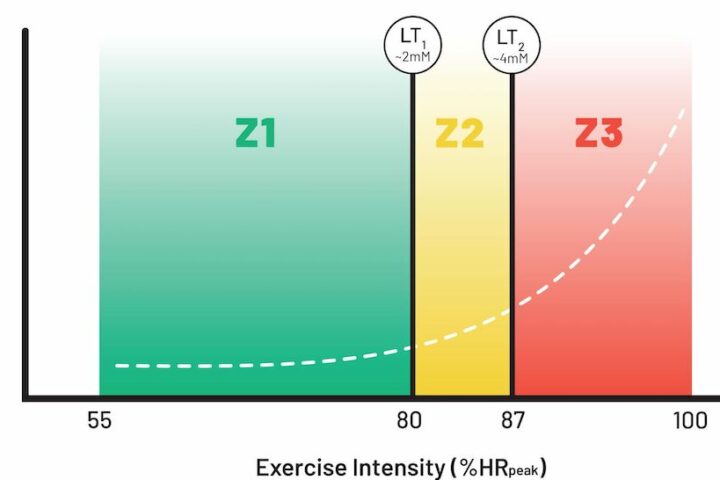
The Science Behind Polarized Training
How is polarized training different from other training methods?
Let’s take a look at how polarized training stacks up against some other training methods that have been widely adopted in recent years—sweet spot and pyramidal.
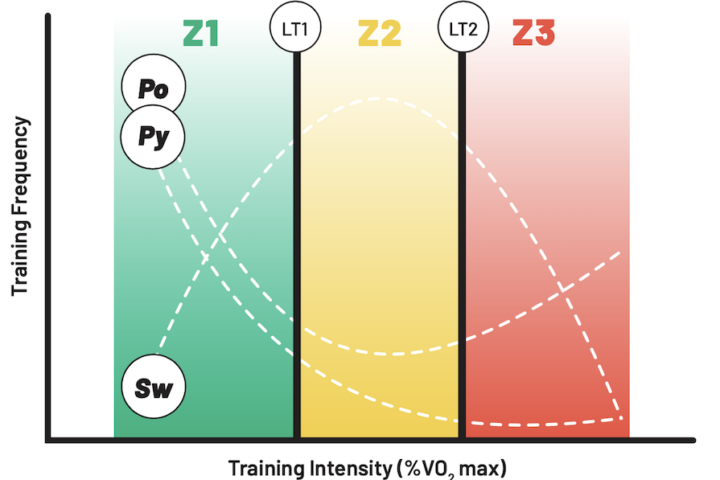
A Comparison of Polarized, Sweet Spot, and Pyramidal Training
How to Manage Training Stress
Easy does it
We all love those hard, intense sessions where we feel fit, fast, and strong—but those workouts need to be carefully placed within a training program in order for maximum gains to be made. In the video below, Dr. Seiler explains the importance of intensity distribution and how much an intelligently designed program can bring to your training.
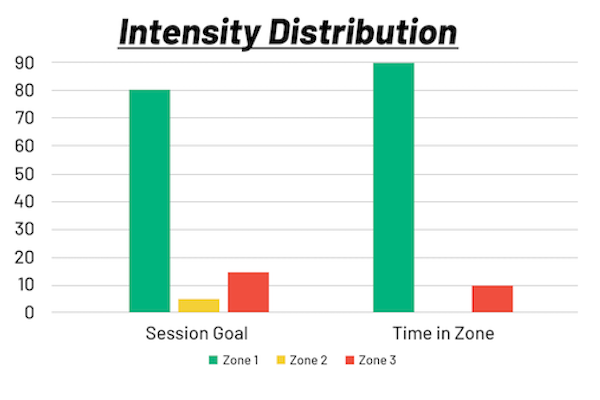
How to Measure Intensity Distribution
Where athletes go wrong
As Dr. Seiler has emphasized, polarizing your training involves being disciplined: making sure the easy is easy and the hard is hard: “The concept of training monotony goes right to the heart of why polarized training works. One of the best ways to overtrain an organism is to subject them to daily stress that is at the same level. We want to keep a lot of the training under the ‘stress radar.'”
He added: “We want to train to signal adaptations at the muscular level without turning on a big stress response. Elite athletes are very good at managing their training so that they don’t turn on that stress response too often. When they do flip the switch to do high intensity work, they are able to kick back. But they stay under the radar a lot with low intensity training.”
A study comparing the training of pro and amateur cyclists found the primary difference to be this: The pros have lower variability in their training, meaning if they do an easy workout, it’s all easy—they’ll crawl up a hill if that’s what it takes to stay in zone 1. Likewise, when they train hard, they train at a higher intensity.
RELATED: Understanding Stress and Its Impact on Your Athletic Potential
Cyclists, runners, triathletes—any type of endurance athlete—can easily fall prey to the “more is more” mentality, which often leads to illness, injury, overreaching, or overtraining. By being disciplined with the intensity distribution of your training, you can significantly reduce the chances of overdoing it—while also increasing your chances of success. Find out more in the video below.
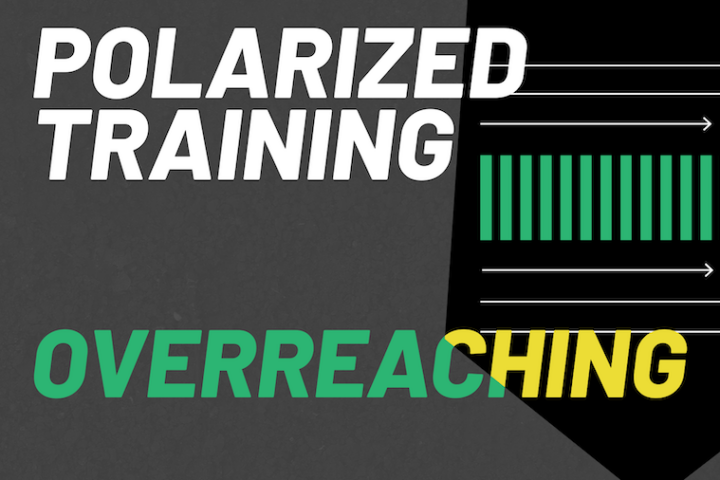
How Polarized Training Can Save You From Overreaching
Rethink, rewind, reset
Perhaps you can see where you’ve gone wrong with your training in the past. Perhaps you’re ready to bring a fresh approach to your program. Following the polarized training approach doesn’t need to be complex—and resetting and rethinking your training won’t take as long as you think it might. Dr. Seiler guides you through this reset process in the article below.

Do You Need to Rethink Your Training?
How to Polarize Your Training
Theory and science are all well and good, but at some point, it’s time to put the theory into practice. In the articles below, we have some key workouts that will help you polarize your training.
RELATED: The 8 Golden Rules of Polarized Training
How to focus your workouts
Most athletes have some staple workouts that they use as benchmarks throughout the training season. When following the polarized approach, there are three key sessions: long, slow endurance work, hard high-intensity work, and zone 1 recovery work. In the articles below, we have workouts for cyclists and runners, as well as some key run and swim workouts for triathletes. These workouts are enough to start you on a path to polarized training.
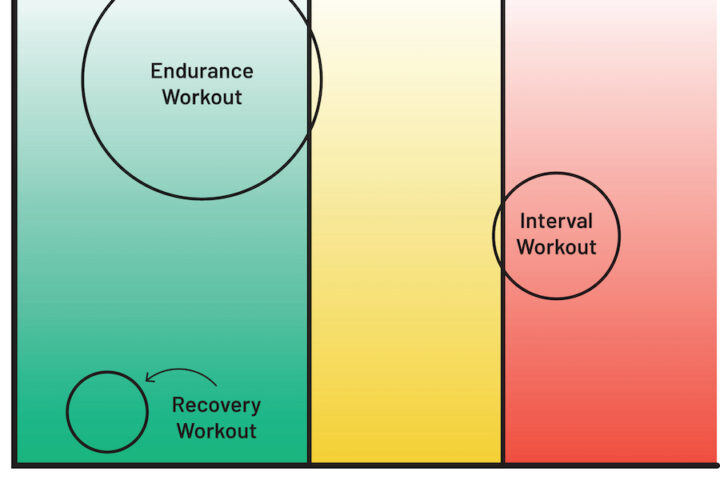
Three Rides to Polarize Your Training
The multi-sport dimension
Polarized training is just as popular with triathletes and runners as it is with cyclists. But what does that look like on a workout-by-workout basis? We find out with help from one of triathlon’s leading coaches, Ryan Bolton.

Polarized Training for Runners
Time to tri it
Triathletes are well-known for going too hard, too often. But some of the most successful multisport contenders have learned that going slow (most of the time) really can help you get faster. Check out these workouts from Ryan Bolton in the article below to find out more.

Polarized Workouts for Triathletes
Who holds the keys to unlock performance?
Between coaches and athletes, researchers and experts, there is a flood of data, experience, and science. Polarized training was born out of a new partnership where science and the real world are beginning to collaborate in meaningful ways.

Polarized Training Science vs. Practice
Explore the Fast Talk archives
It’s no secret that here at Fast Talk we have been long-time supporters of the polarized approach. On your next long, slow workout or recovery session on the trainer, maybe you’d like to have a listen to a few of these gems from our archives. In each podcast, you’ll hear more from Dr. Seiler and Trevor Connor, along with other experts, coaches, and pro athletes.

Polarizing Your Training, with Dr. Stephen Seiler
In Fast Talk episode 54, Dr. Seiler takes a deeper dive into the two thresholds that define your three physiological zones. Find out how to get your zones, and your training right. If you don’t have access to the lab, you’ll get valuable advice on how to more accurately estimate these thresholds. Listen to our podcast on Applying the Polarized Model in the link above for more details.
For more detail on how to execute high-intensity sessions, check out Fast Talk episode 100. Dr. Seiler walks us through the takeaways from his research on high-intensity intervals. While there is always a place for specificity, the science might prompt you to rethink how you redline.
How to Make Polarized Training Work for You
How to Make Polarized Training Work for You
Once you have a good understanding of polarized training, it’s time to apply these ideas to your own training program. This can bring up a lot of questions:
- My heart rate and my pace or power are indicating different zones—which one should I pay attention to?
- This Zone 1 training is killing me! When will I know it’s working and how much is enough?
- I’ve been training consistently, but I suddenly can’t get my heart rate to go up. What is going on?
- How does polarized training change over the course of the season?
The remainder of this pathway will answer all of these questions and more. With input from Dr. Stephen Seiler, Alan Couzens, and Trevor Connor, you will learn how to adapt the polarized model to meet the goals of each phase of your training over the course of the season. Most importantly, you will figure out how to gauge your own external and internal metrics for best results.
In the video that follows, Dr. Seiler explains the difference between external and internal metrics—the external load of an effort and your body’s internal response to that effort.
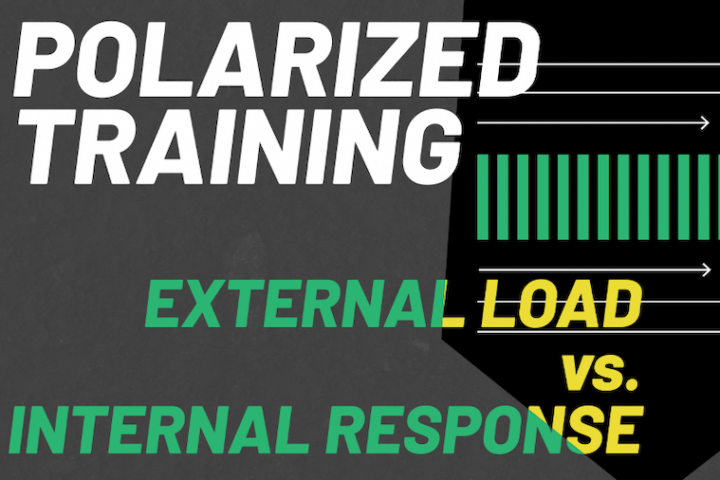
External Load vs. Internal Response
In the video, Dr. Seiler invited us to prioritize internal responses to training, letting heart rate be our guide, early in the season. We want to achieve a steady state with limited stress, reserving that stress for limited high-intensity training. As we get closer to race preparation, it’s time to “turn the screws” and maintain that external load, even if it means we see heart rate creeping upward. Here are some key takeaways for polarized training over a season.

5 Things to Know About How Polarized Training Changes Over a Season
Earlier in the Polarized Pathway, Coach Connor highlighted three rides to polarize your training. Developing endurance with long slow distance sessions is both key to successful base training and polarized training throughout the year. The article that follows takes a closer look at the science of going slow to be fast.
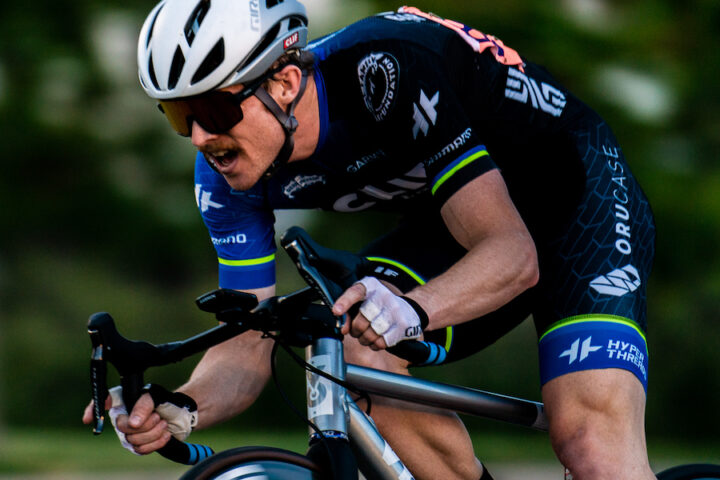
The Science Behind Going Slow to Be Fast
Knowing how to apply this science to your own training is crucial if you really want to see the greatest gains. In the article that follows you’ll find some practical takeaways to help you do exactly that.
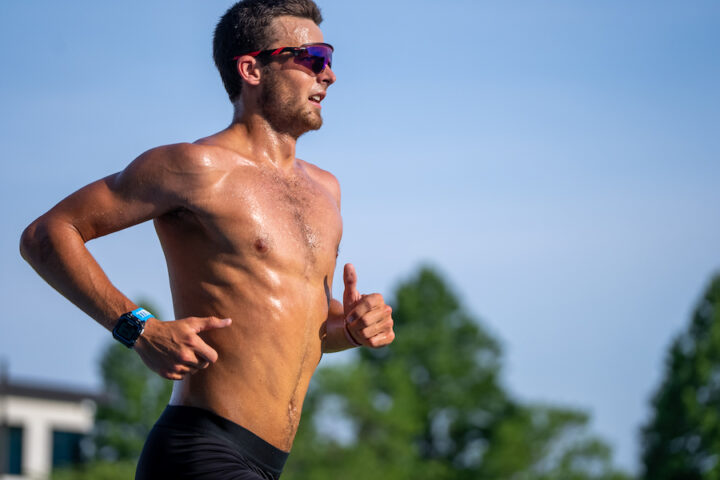
The 8 Golden Rules of Polarized Training
Dr. Seiler’s definitions of training load, stress, and strain will help you maximize the gains that polarized training offers. Progression is truly dynamic. By simply following a rigid training plan and focusing on building stress, you will miss signs of strain that indicate the need to change course. In the article that follows, Coach Alan Couzens reviews the effect of stress on the body. You might be surprised to find out that those deadlines at work have a similar effect on your body as a threshold session.
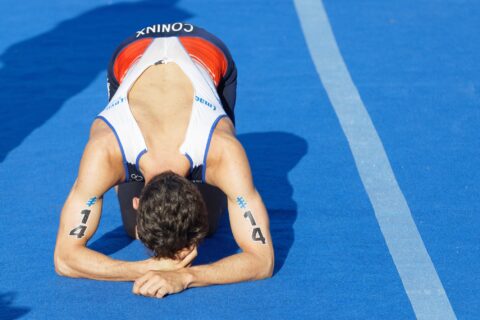
Understanding Stress and Its Impact on Your Athletic Potential
Armed with an awareness of the effect of autonomic stress, both from training and life, we approach the pinnacle of polarized training: durability. Trevor Connor explains what durability is, how you can take stock of your present durability (or lack thereof), and what you can do to improve it over time.

How to Achieve Polarized Training’s Greatest Prize: Durability
Polarized Training as a Path to Performance
In the short term, here’s how you will know polarized training is working.
Heart rate, an internal response to a given load, is a key metric in the polarized method, and it factors prominently in the plan for building durability. But even before you see improvements in durability, you might see your maximum heart rate go up. This is a sign that you are on the right track, already progressing. It’s also an indication that up until this point, you’ve not been rested enough to hit your true maximum heart rate. As you move forward with training, you might get greedy for gains and again see that maximum heart rate dip back down—if that happens, take note and dial in your recovery.
In the long term, expect bigger gains from polarized training
Dr. Seiler promised that polarized training is a winning strategy for the long game. As an athlete, it’s easy to find yourself swept up in the goals of the present season, but let’s take a closer look at some of Dr. Seiler’s case studies to see what you can expect in the longer term—three, four, and five years down the road.
This first case study involves a world-class Nordic skiier Marit Bjørgen who pivoted to polarized training when she hit a performance slump in 2007/2008. Notice that’s also the point where her high-intensity training peaked, but her podium finishes were not happening. Upon shifting the mix of training intensity, not only was she able to resurrect her career as a professional athlete, she was able to train more. As she allowed more time for those long, slow miles, she had increased capacity for training, hitting her highest annual training hours over the five-year stretch of peak performance.
In the graphs that follow, you can see both the macro view of training over the course of her storied career, along with an example of what her polarized training looked like throughout the season.
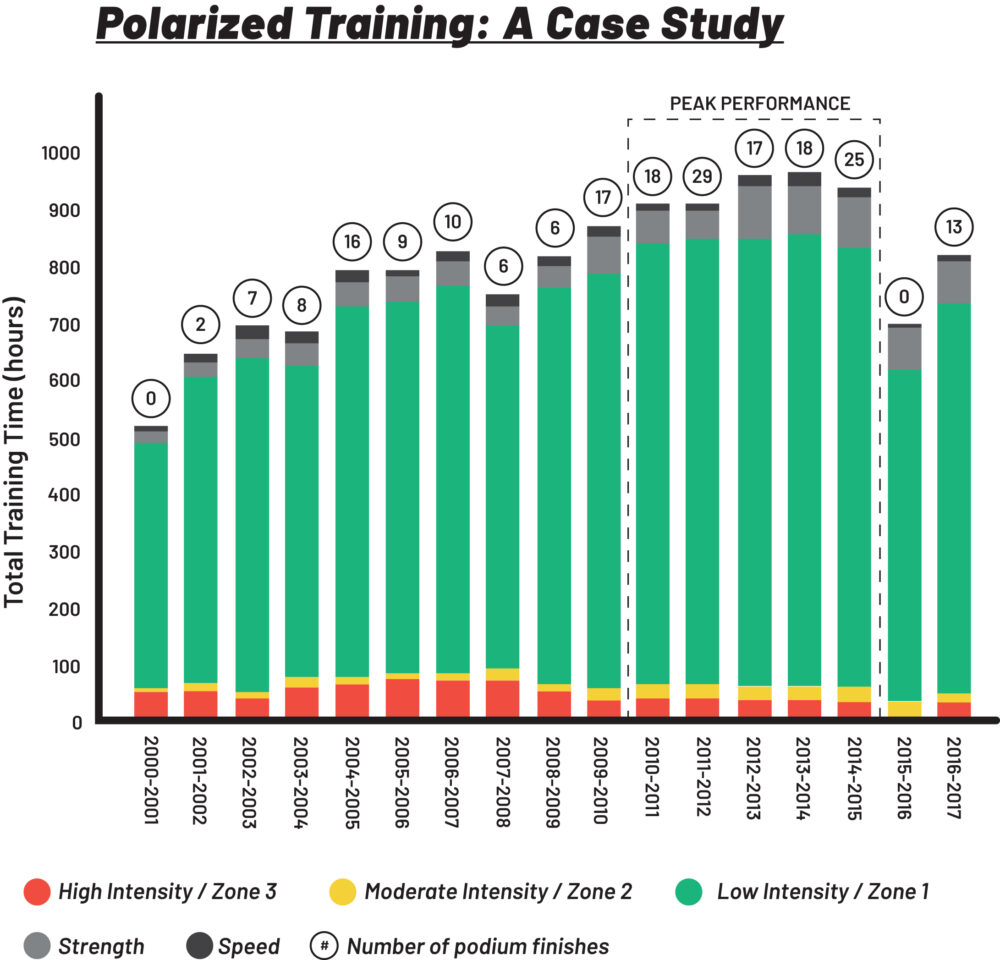
Most coaches are vying for the chance to work with juniors because there is huge potential for performance gains. There are two ways coaches can go about this, picking off the easy wins or building a foundation for successful career.
Junior athletes usually respond well to high-intensity work, at least in the short term, so many coaches will continually increase the load, namely intensity, to meet the athlete’s capacity. As we saw in the early years of Marit Bjørgen’s career, this can put the athlete on the podium, but it can also cut their career abruptly short.
Here is another case study from Dr. Seiler that profiles a young up-and-coming junior cyclist, Norwegian Per Strand Hagenes in the first few years of his career. You will see that once again, with a greater volume of work at low-intensity, and a potent, but much smaller, amount of work at high-intensity, this cyclist was able to increase his overall training volume.
Earlier in this pathway, we talked about the different ways to categorize intensity and how that can affect the mix of training intensities. In this case, you are seeing this athlete’s power data, or time in zone. You’ll notice that this means even less time in Zone 3 than if they had categorized it by workout intent. Recall that the power data is capturing just the time doing the hard interval. The warm-up, rest and recovery during the same workout will all be in Zone 1 or Zone 2. Categorizing the intensity according to session intent, which would place the entire workout in Zone 3.
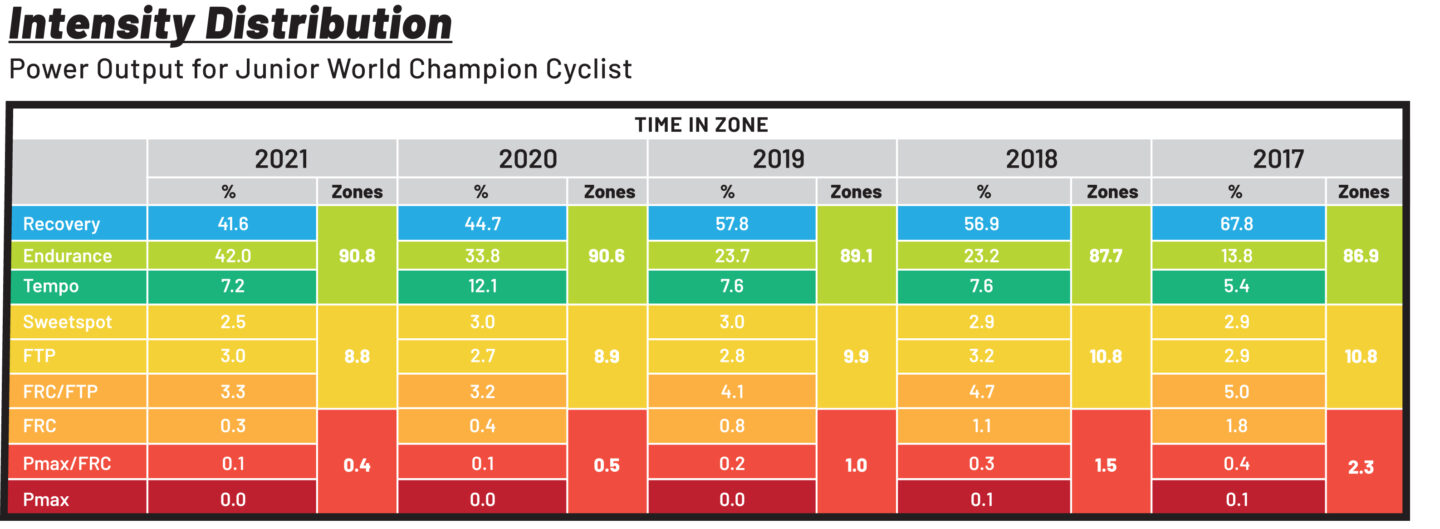
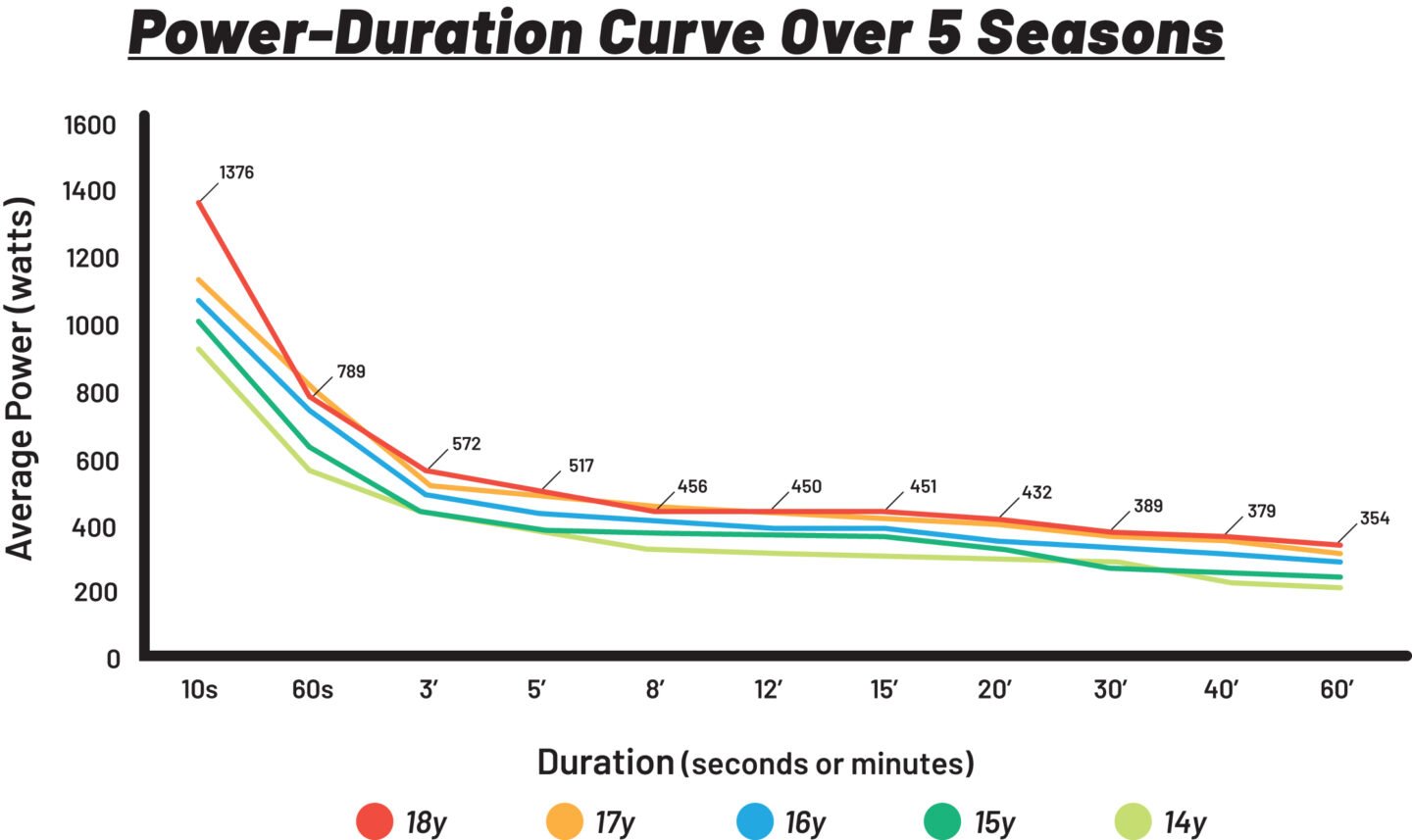
With the promise of performance on the horizon, let’s set some expectations for mere mortals—age groupers and masters athletes who are not embarking on a professional career in sport. The power-duration graphic that follows has been adapted to better reflect gains that you might expect over several seasons of polarized training.
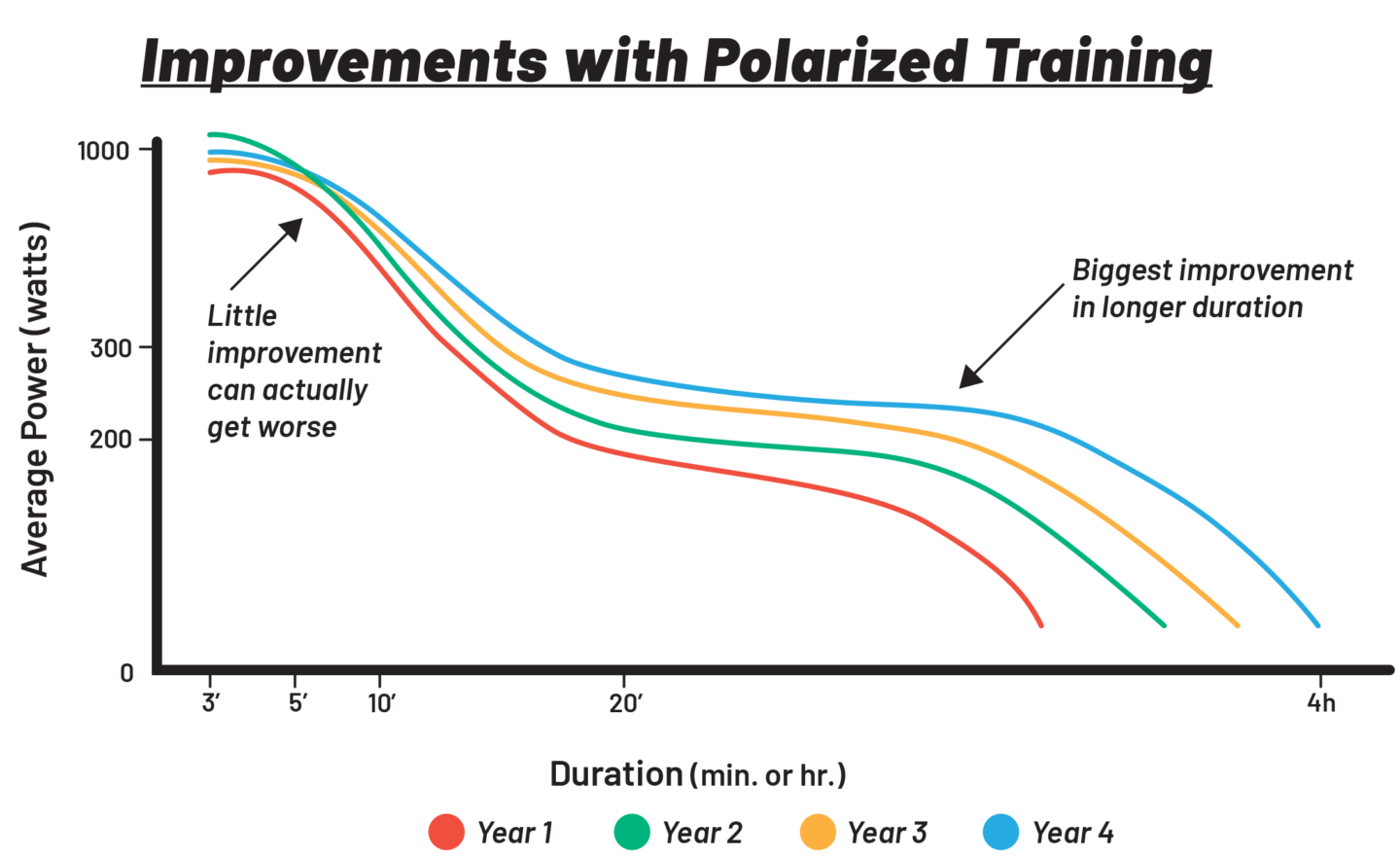
In comparing this set of power-duration curves to our junior cyclist, you’ll see the biggest difference is that most of us will see minimal improvements in our sprinting since our sprint strength tends to peak at young ages. Our junior athlete experienced a large increase in his sprint power likely because he was under 18 years of age, which meant he was going through adolescence and putting on a lot of muscle mass. For masters athletes, the real improvements can be found at the longer durations.
As you embark on your own application of these methods, use our form to compare notes with other athletes or sign up for a data analysis session to get a fresh perspective on your training data and your individual progression. We look forward to hearing about how polarized training works for you.
Join the conversation
Do you have additional polarized training questions that you would like answered by our staff and endurance community? Head over to our forum and post there to collaborate, find additional answers and insights, and supportive tips about how to approach polarized training.
STILL NEED HELP?
Polarized training is an exciting new avenue for athletes to explore. If would you like more personalized help, schedule a free consultation with us, and we will help you develop an individualized plan moving forward.

